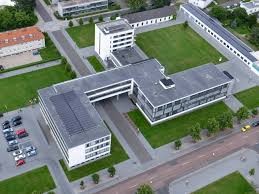University of Chicago
Founded by Walter Gropius in 1919, Staatliches Bauhaus, known simply as Bauhaus, was a German school of art that sought to combine craft and technique. Despite only existing for a mere 14 years, the school left lasting impacts on all forms of arts; we shall largely concern ourselves with its architectural impacts.
Bauhaus had a very tenuous relationship with the government in Weimar, which ultimately led to the school reestablishing itself in Dessau. The “parochial decisions” of the government at the time were not taken well and many fought for the Bauhaus to remain, as its place among art schools was unique, in that it was one of the few that encouraged its students not to mimic, but to create.
Hannes Meyer was appointed as the new director by Gropius in 1928.1 Meyer, however, was concerned largely with social issues and quickly became opposed to the classical Bauhaus ideals, so much that he wrote “I found myself fighting the Bauhaus style.” Meyer resigned in 1930 due to increasing pressure from the school itself, as well as the Dessau authorities because of his staunch support of extreme leftism and promotion of such views. Despite his rocky directorship, Meyer was a key component in imparting and reinforcing the idea that architecture was a social art. Architecture was first and foremost for the people, and hence that functionality was key.
Ludwig Mies van der Rohe was offered the directorship directly after Meyer’s resignation. Unsatisfied with Dessau’s requirements for the university, Mies moved the school to Berlin as a private venue in 1932, but it only lasted for a short six months until the Gestapo occupied and shut down the school under Hitler.
In figure 1, we can see the Bauhaus Dessau, designed by Gropius. Architecturally, there are three main wings, all of which are connected. Symbolically, this reinforces the Bauhaus idea that all forms of art were intrinsically unified. Furthermore, by having the student’s dormitories connected to the rest of the building, it becomes clear that all of architecture is a social aspect, not only residential architecture.
 Figure 1: Bauhaus Dessau
Figure 1: Bauhaus Dessau
Architect: Walter Gropius
Location: Dessau, Germany
Photo by: M_H.DE
The Bauhaus was one a pioneering school for modern architecture; many of its modern ideas can be seen in figure 2. The emphasis on volume and not mass is made clear by the extensive use of glass along the wall, leading to a more open and free form. Furthermore, the typeface on the building was an important innovation from Bauhaus. Typography was seen as an art in an of itself. Bauhaus typographers paved the path for modern typographic structures, such as the lack of capitalization and free form letters and compositions. The free form structure of typography proves a more organic approach, which resonates closely with modernist ideologies.
 Figure 2: Bauhaus Dessau
Figure 2: Bauhaus Dessau
Architect: Walter Gropius
Location: Dessau, Germany
Photo by: Dr. Volkmar Rudolf/Tilman2007
-SR
Figure 1: M_H.DE, Dessau, Bauhausgebäude. Licensed under CC BY 3.0 via Wikimedia Commons. Available at Wikimedia, link (accessed November 15, 2015).
Figure 2: Dr. Volkmar Rudolf/Tilman2007, Bauhaus Dessau-001. Licensed under CC BY-SA 3.0 via Wikimedia Commons. Available at Wikimedia, link (accessed November 15, 2015).
Notes: